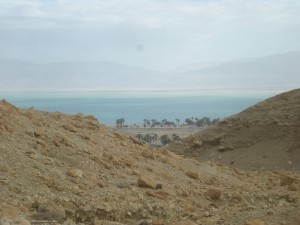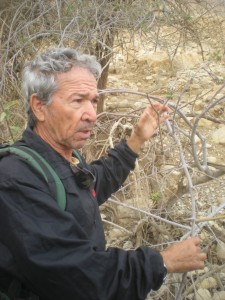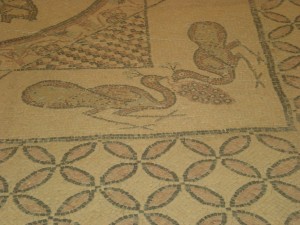
(Catching up on writing about the siyurim/tours we’ve had so far, this one is from a little over a month ago.)
When most people think of Ein Gedi, they think of a beautiful oasis sandwiched between the cliffs at the end of the Judean Desert and the highly saline Dead Sea, the lowest place on Earth at 422 meters (1385 feet) below sea level. Popular images that spring to mind related to this oasis include gorgeous waterfalls, colorful flowers and delicate ibex bounding along sharp cliffs. Others might think of the date crops that were so closely connected with this area.
But what is somewhat less prominent, but still highly significant, is the wealth of interesting (and at times perplexing) archaeological finds within the Ein Gedi area. I wanted to highlight a couple of the archaeological sites that you might want to see on your next trip to the Ein Gedi park.
First, a drop of history on the historic town of Ein Gedi. The earliest physical evidence we have of a settlement at this location is from the 7th Century BCE. But even before then, there was a presence here. Up in the hills above Nahal David, near the Shulamit Spring, there is a temple that dates to the Chalcolithic Era.
The town is mentioned multiple times in the Bible, and is referenced as an important commercial center by Pliny the Elder. It was apparently destroyed violently in the 6th Century C.E., though the specific circumstances are unknown.
Ein Gedi was an important economic center for a long time, and featured prominently both in the production of dates as well as the production of various precious herbal essences, most notably the Afarsimon. As with so many things connected to this area, what Afarsimon was exactly remains shrouded in mystery. What we do know, however, is that it was a very expensive and valuable product, that Ein Gedi was the center of its production, and that the method of its production was itself a closely guarded secret.
Another bit of archaeology, nearby to the Chalcolithic Temple, is a stone mill house. What makes this a somewhat confusing site is that it is much larger than should have ever been needed by a settlement of the size that Ein Gedi was.
I want to focus, however, on two other interesting archaeological sites, one of which is easily accessible, the other which you may only be able to view from a distance (or perhaps might be able to visit with special permission, or if they open a trail to there in the future).

There are two main wadis in Ein Gedi: Nahal (or Wadi) David on the north side and Nahal Arugot on the south. Though there are a number of trails in Nahal Arugot that are hikeable, parts of it are still inaccessible to the general public. Luckily, our guide at Ein Gedi was the amazing Eli Raz, or as I like to call him, “Mr. Ein Gedi.”
There is much that could be said about Eli Raz, but suffice it to say there are few people who know as much as he does about the geology of the Dead Sea region in general, and the history of Ein Gedi in particular. So when our planned hike was canceled due to flooding from the torrential rains of the previous day, Eli was able to take us up in Nahal Arugot to a part that is not on a marked trail.
About halfway up this wadi, one can see a well-preserved stone fortress. It is a very impressive structure, originally of multiple levels, built of large stones and plastered from the outside. It is by far the strongest construction of anything in the immediate area, contains two separate plastered water pools (one inside the fortress and one outside, connected by a small channel through the wall), had barred windows and is architecturally complex as well. One of the most intriguing features is an elaborate double wall in front of the inner chamber, with a massive round stone that could be rolled in front of the door to lock it from the inside.

What exactly was the purpose of this building? It seems overly fortified, and yet remains too small to be a fully operating fortress, full time. Plus, it is up in the hills, not directly next to the settlement it might have been protecting.
One possible answer goes back to the Afarsimon production I previously mentioned. As I said, we know this was a secret process, and also a very valuable one. One theory is that the inner chamber was the place where they produced the actual product. The specially blocked door would prevent others from learning the secret. The two pools, connected through the wall, allowed farmers to put the branches of whatever tree the essence was extracted from into the outer pool. Then the two pools would be filled with olive oil, allowing some of the essence to leach out, into the inner pool. Whoever was inside the inner chamber would then produce the Afarsimon from the inundated oil.
A more known and accessible site at Ein Gedi is the ancient synagogue. Located right in the front center of the park and covered with a distinctive white tent, it has many unique architectural features, and is best known for its large and well-preserved mosaic floor (dated to the 6th Century C.E.). The synagogue was built in sections, with a late expansion on a smaller earlier building. Unlike almost all synagogues from that time, which typically had their entrances from the north, the door here was on the western wall. Also, there is no human imagery in the mosaic, similarly contrary to other synagogues from that time.
There is virtually no Christian influence in the architecture, and so it is not really valid to refer to it as a Byzantine era synagogue, despite the era in which it actually existed. All of these differences suggest that the Ein Gedi community was somewhat disconnected from the rest of Jewish Israel.

The side of the floor has a large mosaic with many distinct sections containing writing in Aramaic. This well-known inscription is one of the most important finds at the synagogue. In addition to a list of generations of the Biblical forbears, a pairing of the months with the astrological signs and a few tributes to wealthy donors to the synagogue (seems like very little has changed in 1500 years!), there is also a piece with instructions on how to live as a part of the Ein Gedi community. Among other things, it warns that God will severely punish “whoever reveals the secret of the town.”
Again this is somewhat mysterious. What “secret of the town” was this? One popular theory is that it might simply have been the method of Afarsimon production, again underscoring the significance of this industry to the town’s economy. But another interesting theory is that the Jews in Ein Gedi might have belonged to a similar Essene sect to the residents of nearby Qumran. This might explain some of the unique features of this synagogue, and also might connect to another distinctive feature.
When they first uncovered the mosaic on the floor of this synagogue, they lifted it up in sections to see what was beneath it (apparently a standard procedure). They found another mosaic floor (also not uncommon, apparently) which featured a swastika, among other things. While the swastika obviously generates uncomfortable feelings in modern Jews, it is an ancient symbol with roots in mysticism and the like. The swastika here could indicate a connection with a more secret sect of Judaism, such as the Essenes.
Regardless of the meaning, there is certainly a lot of interesting and beautiful archaeology to be seen at Ein Gedi, in addition to all its natural beauty. I’d definitely recommend taking some time to check some of it out the next time you find yourself in the area!

Hi Joel.
This was again a great article. I do not remember, that I ever heard about the svastika beyond the floor. Thats also I nice story for tourists I guess.
I would like to support your blog and add a few things that I found important about the sites you visit.
a) Another good story for tourist bring us back to the bible. You probably know the story, when David was hiding in a cave in En Gedi from King Saul. He even had to possibility to kill Saul but did not do it.
b) I think to remember, that the Afarsimon was also connected by some archeologists to the production of parfume.
c) Interesting for jewish tourists might be the fact, that Jews lived here during the 2. Temple time and in roman times an there is a discussion about the question, if Jewish residents were for or against Bar Kochba Uprising.
d) Near the synagogue you can also find the remains of a street, a Miqwe and a number of buildings from the village that stood here in byzantine times.
e) In the synagogue, they also discovered not less than 5000 coins in in the synagogue’s cash box near the Ark.
f) In my “Doch Siur” I wrote down, that the secret in the synagogue might also have to do with Kakifruit or balsam, but I cant make the connection anymore. So if anybody knows more, this would be great.
Looking forward to read your next blog.
kaduri
Kaduri —
Thanks much for the comments! Good stuff to add. I did know much of that, but was not familiar with the points you make in “d” about the street, etc. We did not go to see that. Thanks!
Re: “f,” I am not sure what “kakifruit” is, so I can’t speak to that, but balsam refers to one of the potential plants that is believed to be the source of the Afarsimon essence.